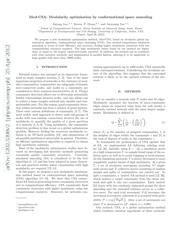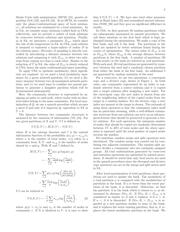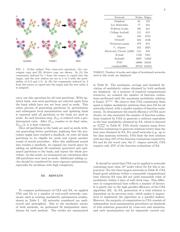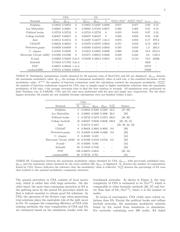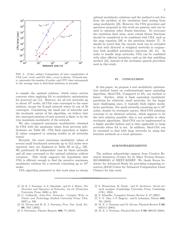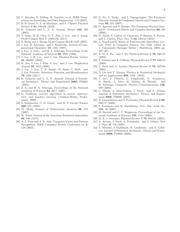Datasheet 搜索 > 开发套件 > TI(德州仪器) > WL1837MODCOM8I 数据手册 > WL1837MODCOM8I 其他数据使用手册 1/6 页
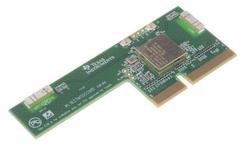
¥ 440.761
WL1837MODCOM8I 其他数据使用手册 - TI(德州仪器)
制造商:
TI(德州仪器)
分类:
开发套件
描述:
WiLink™ 8 WiFi/蓝牙/BLE 评估套件Texas Instruments 评估模块使客户可为家用和楼宇自动化、智能能源、网关、无线音频、可穿戴产品和更多工业及物联网 (IoT) 应用添加 Wi-Fi® 和 Bluetooth®。 WL1837MODCOM8I 是经认证的 Wi-Fi® 双频带、蓝牙和 BLE 评估模块,可与很多处理器兼容,包括 Texas Instruments Sitara™。 可以从 Texas Instruments 免费提供 Linux 和 Android 高级操作系统 (HLOS) 驱动器,用于 Sitara™ AM335x MPU。 WLAN、蓝牙 4.1 和 BLE 可集成在单一评估板上 WLAN 2.4 和 5 GHz SISO(20- 和 40- MHz 通道),2.4 GHz MIMO(20-MHz 通道) 与 Sitara™ 和其他应用处理器无缝集成 共享 HCI 运输,适用于蓝牙、BLE (UART) 和 SDIO (WLAN) 内置芯片天线,具有 WiFi/蓝牙单天线共存性 可选 U.FL RF 连接器,用于外部 2.4-GHz 频带天线 使用外部 SMPS 直接连接到电池,从而 在 1.8V 域中支持 2.9 到 4.8V 输入/输出电压 ### WLAN(无线局域网)- Texas Instruments展开
Pictures:
3D模型
符号图
焊盘图
引脚图
产品图
WL1837MODCOM8I数据手册
Page:
of 6 Go
若手册格式错乱,请下载阅览PDF原文件

arXiv:1202.5398v2 [physics.comp-ph] 25 Apr 2012
Mod-CSA: Modularity optimization by conformational space annealing
Juyong Lee,
1, ∗
Steven P. Gross,
2, †
and Jooyoung Lee
1, ‡
1
School of Computational Sciences, Korea Institute of Advanced Study, Seoul, Korea
2
Department of Developmental and Cell Biology, University of California, Irvine, USA
(Dated: April 26, 2012)
We propose a new modularity optimization meth od, Mod-CSA, based on stochastic global op-
timization algorithm, conformational space annealing (CSA). Our metho d outperforms simulated
annealing in terms of both efficiency and accuracy, finding higher modu larity partitions with less
computational resources required. The high modularity values found by our method are higher
than, or equal to, the largest values previously reported. In addition, the method can be combined
with other heuristic methods, an d implemented in parallel fashion, allowing it to be applicable to
large graphs with more t han 10000 nodes.
I. INTRODUCTION
Network scienc e has emerged as an important frame-
work to study complex systems [1, 2]. One of the most
important properties of networks is the existence of mod-
ules/communities; communities are subgraphs of densely
inter- c onnected nodes, and nodes in a community are
considered to share common characteristics [3, 4]. Prop er
community detection allows one to de termine potentially
hidden relationships between nodes, and also allows one
to reduce a large complex network into smaller and com-
prehensible ones. For this reason, good community detec-
tion within networks has been a subject of gr e at interest.
There exist various definitio ns of co mmunity [4–7]. The
most widely used approach to detect such sub-groups of
nodes with non-random c onnections involves the use of
modularity to quantify the quality of a given pa rtition
of a network [4, 8, 9]. Using modularity, the community
detection problem is thus r ecast as a global optimization
problem. However, finding the max imum modularity so-
lution is an NP-hard problem [10], and enumeration of
all pos sible partitions is intractable in general. Therefore,
an efficient optimization algorithm is r equired to obtain
high modularity solutions.
Most of the modularity optimization studies have fo-
cused on developing fast heuristic methods generating
reasonable quality community struc tures. Currently,
simulated annealing (SA) is considered to be the best
algorithm [4, 11] and has been adopted in many theoret-
ical and practical studies where communities with high
modularity are require d [12–14].
In this paper, we propose a new modularity max imiza-
tion method based on conformational space annealing
(CSA) algorithm [15–19]. We show that CSA outper -
forms SA both in generating better community structures
and in computational efficiency. CSA consistently finds
community structure s with higher modularity using less
computational resources. Moreover, for networks con-
∗
juyong@kias.re.kr
†
sgross@uci.edu
‡
jlee@kias.re.kr
taining approximately up to 1000 nodes, CSA repeatedly
finds converged solutions. Considering the stochastic na-
ture of the algor ithm, this suggests that the converged
solution is likely to be the optimal solution of the net-
work.
II. METHODS
Let us conside r a network with N no de s and M edges.
Modularity measures the fraction of intra-community
edges minus its expe c ted value from the null model, a
randomly rewired network with the same degre e as sign-
ments. Modularity is defined as
Q =
N
c
X
i=1
l
i
M
−
D
i
2M
2
!
, (1)
where N
c
is the number of assigned communities, l
i
is
the number of edges within the community i and D
i
is
the sum of degrees of nodes in the community i.
To benchmark the perfo rmance of CSA against that
of SA, we implemented SA following existing stud-
ies [12, 20]. Initially, using E = −Q, a simulation starts
at a high temperatur e T , to sample broad range of the so-
lution space as well as to avoid trapping in local-minima.
As the simulation proc eeds, T is slowly decrea sed to more
completely explore basins of high modularity. At a given
T , a se t of stochastic movements including N
2
single-
node moves and N collective moves consisting of random
merges and splits of communities, are carried out. To
split a community, a ’nested’ SA method is used [12, 20],
which isolates a target community from the entire net-
work and split it into two communities. Each ’nested’
SA starts with two randomly separated groups for short
annealing and the annealed solution serves as a collec-
tive move. For each trial movement, if Q increases, the
movement is accepted, otherwise it is accepted with prob-
ability P = exp
Q
f
−Q
i
T
. After a set of movements are
tried, T is decreased to αT , whe re α = 0.995.
Our method, CSA, is a global optimization method
which combines essential ingredients of three methods:
器件 Datasheet 文档搜索
AiEMA 数据库涵盖高达 72,405,303 个元件的数据手册,每天更新 5,000 多个 PDF 文件

